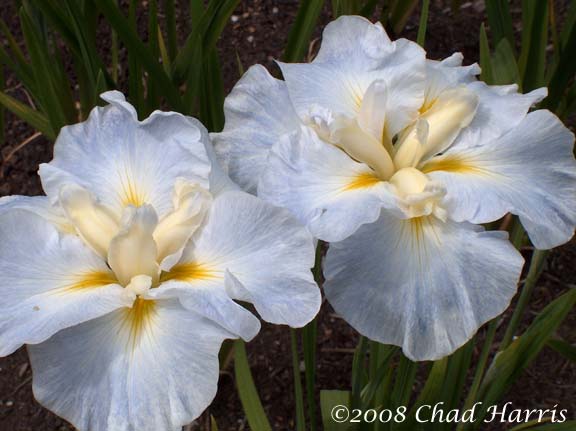By Renee Fraser
So many blues, so little space!
In the last post on blue irises, people shared their favorite blue tall bearded irises. But bearded irises are not necessarily the bluest of the blues; indeed, Siberian irises, Japanese irises, and Louisiana irises come in blues to melt your heart. So here are the truest blues, the prettiest blues, and the best performing blues in these categories from my random poll of iris growers and gardeners across the Internet.
Let us start with Japanese irises, also known as ensatas. The top vote-getter for favorite blue was
'Lake Effect'. Take a look at that sky blue color!
 |
| 'Lake Effect' |
Chad Harris, an iris hybridizer, flower photographer extraordinaire, and owner of
Mt. Pleasant Iris Farm in Washington, claims
'Banjo Blues' as his top pick, but he couldn't help throwing in a lovely pale blue, '
Bewitching Twilight'.
 |
| 'Banjo Blues' |
 |
| 'Bewitching Twilight' |
Marilyn Campbell, who lives in Massachusetts, loves
'Sing the Blues'. Her photo tells you why.
 |
| 'Sing the Blues' Photo by Marilyn Campbell |
Unlike the bearded irises, Japanese irises require moist soil to thrive, as do
Louisiana irises, natives to the bayous of the state. Like Japanese irises, Louisianas can be grown in boggy conditions.
Louisianas come in a wide range of colors, including some stunning blues. A recent poll at a San Fernando Valley Iris Society meeting found the blue Louisiana iris
'Sinfonietta' a popular choice, and here's
why: take a look at Evan Layne's beautiful photos, close-up and in the garden.
 |
| 'Sinfonietta' |
 |
| 'Sinfonietta' Photo by Evan Layne |
 |
| 'Lake Sylvia' |
Another gorgeous Louisiana blue is recommended by Patrick O'Connor of Zydeco Louisiana Iris Garden. He says 'Lake Sylvia' "may be the most brilliant, saturated blue available."
Ron Killingsworth, one of the contributors to this blog, lives and gardens in Louisiana. He has seen just about every Louisiana iris, and his very favorite blue is 'Southdowns' by Patrick O'Connor. He says it is a very soft blue.
 |
| 'Southdowns' Photo by Ron Killingsworth |
Ron also likes
'Little Rock Skies' which is a very pretty blue with short foliage and petite blooms.
 |
| 'Little Rock Skies' Photo by Ron Killingsworth |
Another favorite blue is
'Dural Bluebird' which has some very nice ruffling.
 |
| 'Dural Bluebird' Photo by Ron Killingsworth |
Siberian irises have lovely graceful foliage and come in a great variety of blues.
Polly Kinsman, an avid iris gardener and a grower who owns Siberian Iris Gardens, says 'Careless Sally' is her very favorite.
 |
| 'Careless Sally' |
She also likes
'Shaker's Prayer'. Polly and Denise Stewart, owner of
Snowpeak Iris in Oregon, are administrators of an internet gardening community called
Iris Cubits, where many lovely photos of Siberian irises can be found.
 |
| 'Shaker's Prayer' Photo by Polly Kinsman |
Marilyn Campbell claims 'Lee's Blue' as her favorite blue Siberian iris.
 |
| 'Lee's Blue' Photo by Marilyn Campbell |
A popular blue that is in widespread commercial circulation was shared by Sandra Eggertson. 'Silver Edge' grows well in her garden in Manitoba, Canada.
 |
| 'Silver Edge' Photo by Sandra Eggertson |
Chad Harris grows and sells Siberian irises as well as Japanese. This striking blue iris is his favorite blue Siberian.
 |
'Ships are Sailing'
|
Kathleen Devlin, who gardens in Michigan, sent this photo of 'Cape Cod Boys', her favorite. This clump growing in John and Jean Kaufmann's garden will be even more spectacular by next year's Siberian and Species Iris Convention in June.
 |
| 'Cape Cod Boys' Photo by Kathleen Devlin |
Which of these beauties is your favorite? Do you grow any blue beardless irises, and if so, which do you think is your truest blue?

























